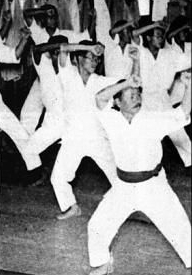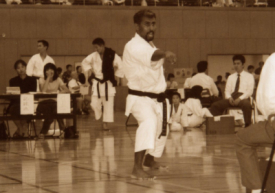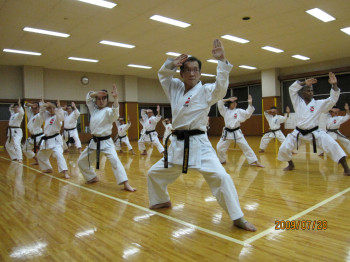 |
 |
Japan Karate Do Hakua-Kai Matsubushi Dojo |
|
|
|
|
 |
 |
 |
KATA(形)
Kata is often described as a set sequence of karate moves organized into
a pre-arranged fight against imaginary opponents.The kata consists ofblocks,punches,kicks,strikes,sweeps
and throws.Body movement in various kata includes
stepping,twisting,turning,dropping to the ground and jumping.In kata is
not a performance or a demonstration,but is for individual karateka to
practice full techniques-with every technique potentially a killing blow
( ikken hisatsu )-while paying particular attention to from and timing
( rhythm ).As the karateka grows older,more emphasis is placed on the health
benefist of practicing kata,promoting fitneess while keeping the body soft,supple
and agile.There are perhaps 100 kata across the various forms of karate,
each with many minor variations.The number of moves in a kata may be referred to in the name of the kata.The
ultimate Gōjū-ryū kata, Suparinpei, literally translates to 108. Suparinpei
is the Chinese pronunciation of the number 108, |
| while gojushi of Gojūshiho is the Japanese pronunciation of the number
54. The other Gōjū-ryū kata, Sanseru (meaning "36") and Seipai
("18") are factors of the number 108. The number of moves may
also have links with Buddhist spirituality. The number 108 is significant
in Buddhism, and kata with 54, 36, or 27 moves (divisors of 108) are common.
The practitioner is generally counselled to visualize the enemy attacks,
and his responses, as actually occurring, and karateka are often told to
"read" a kata, to explain the imagined events. The study of the
meaning of the movements is referred to as the bunkai, meaning analysis,
of the kata. |
|
|
|
Kata (形) means literally "shape" or "model." Kata is a formalized sequence of movements which represent various offensive and defensive postures. These postures are based on idealized combat applications.Some kata use low and wide stances. This practice develops leg strength, correct posture, and gracefulness. Vigorous arm movements enhance cardiovascular fitness and upper body strength. Kata vary in number of movements and difficulty. The longer kata require the karateka to learn many complex movements. Diligent training and correct mindfulness lead to real understanding of combat principles.
Physical routines were a logical way to preserve this type of knowledge. The various moves have multiple interpretation and applications. Because the applicability for actual self-defense is so flexible there is no definitively correct way to interpret all kata. That is why only high ranking practitioners are qualified to judge adequate form for their own style. Some of the criteria for judging the quality of a performance are: Absence of missteps; correct beginning and especially ending; crispness and smoothness; correct speed and power; confidence; and knowledge of application. Kata with the same name are often performed differently in other styles of karate. Kata are taught with minor variations among schools of the same style. Even the same instructor will teach a particular kata slightly differently as the years pass.To attain a formal rank the karateka must demonstrate competent performance of specific required kata for that level. The Japanese terminology for grades or ranks is commonly used. Requirements for examinations vary among schools.
|
 |
 |
|
|
 |
 |
Bunkai (分解)
Bunkai (分解), literally meaning "analysis"or "disassembly", is a term used in Japanese martial arts referring
to the application of fighting techniques extracted from the moves of a
"form"(kata).Bunkai is usually performed with a partner or a
group of partners which execute predefined attacks, and the student performing
the kata responds with defenses, counterattacks, or other actions, based
on a part of the kata. This allows the student in the middle to understand
what the movements in kata are meant to accomplish. It may also illustrate
how to improve technique by adjusting distances, time moves properly, and
adapt a technique depending on the size of an
opponent.Some kata have another layer of application that is taught using
an Oyo Bunkai, an "application of the kata in ways other than the
standard bunkai.
|
Different practitioners will learn or discover alternative applications, but the bunkai, like the kata, varies based on the style and the teacher.A single kata may be broken into anywhere from a few to a few dozen applications, and the same sequence of kata moves may sometimes be interpreted in different ways resulting in several bunkai. Some martial arts require students to perform bunkai for promotion.Bunkai can be obvious or elusive depending on the technique in question, the moves preceding and following it, and
the individual practitioner.
There are usually many stages of depth of comprehension of bunkai only reached through the passage of time. The terms toridai and himitsu are used to refer to techniques not readily seen to the casual observer and hidden techniques within kata |
|
|
|
Kime (決め)
Kime (決め) is a Japanese word. It is the noun form of the verb "kimeru,"
which means "to decide," "to conclude," etc. In English,
its general meaning is "deciding."Kime is a commonly-used Japanese
martial arts term. In karate it can mean "power" and/or "focus," describing the instantaneous tensing at the correct moment during a technique. The tension at this time is mostly focused on the dantian ("hara") and abdomen. In judo, the "Kime-no-kata " are often translated as the "Kata of Decision." In other budo,the term refers to attacking a pressure point. In all cases, certain finality is implied.
Reference :Wikipedia |
 |
 |
|
 |
 |
Kata(形)
The kata of karate do are logucal arrangements of blocking ,punching, striking
and kicking techniques in certain set sequences.About fifty kata, or "formal
exercises"are practiced at the present time,some having been passed
down from generation to generation,others having been developed fairly
recently.Kata can be divided into two broad categories.In one group are
those approopriate for physical development,the strengthening of bone and
muscle.Though seemingly simple,they require composure fortheir performance
and exhibit strength and dignity when correctly performed.In the other
group are kata suitable for the development of fast reflexes and the ability
to move quickly.The lightninglike movements in these kata are suggestive
of the rapid flight of the swallow.All kata require and foster rhythm and
coordination.Training in kata is spiritual as well as physical.In his performance
of the kata,the karateka should exhibitboldness and confidence,but also
humilty,gentleness and a sense of decorum,thus integrating mind and body
in a singular discipline.As Gichin Funakoshi often reminded his students."The
spirit of karate do is lost without courtesy."
|
| (Reference :(Masatoshi Nakayama) |
|
|
    |
| JAPAN KARATE DO HAKUA-KAI MATSUBUSHI DOJO |